By: Raffaello Sanzio da Urbino (Raphael)
Week: 1
In Raphael's 'Saint George Struggling with the Dragon,' Saint George sits atop a rearing steed and battles a ferocious black dragon to rescue a blonde princess wearing a golden crown. Saint George wears green armor, a velvet cape, and a helmet blooming with green and gold feathers. He raises a wicked looking sword as the dragon snarls and lunges at him. The battle has been ongoing, evident from the broken lance jutting from the dragon's chest.
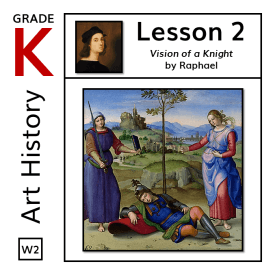
By: Raffaello Sanzio da Urbino (Raphael)
Week: 2
In 'Vision of a Knight,' Raphael paints a knight sleeping on the ground between two women. Both women gaze down upon the knight. The woman on the left holds out a sword and a book. The woman on the right extends a flower. The items held by the women represent the ideal attributes of a knight as a scholar (book), a soldier (sword), and a lover (flower). The painting also includes a mountain range, a city, a bridge over a river, a road with men on horseback, and a great castle in the background.
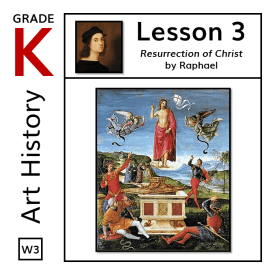
By: Raffaello Sanzio da Urbino (Raphael)
Week: 3
In 'Resurrection of Christ,' Raphael paints the Christian figure Jesus Christ coming back to life and floating over his opened tomb. Christ points toward heaven and holds a white banner. A golden halo glows atop his head. People cower beneath him, and angels fly nearby. Women in halos cluster together in the background. A snake slithers in the bottom left corner of the painting, and a stork struts in the background. Snakes signify rebirth and resurrection because they shed their skins. Storks represent renewal and new life. The white banner with a red cross held by Christ symbolizes his victory over death.
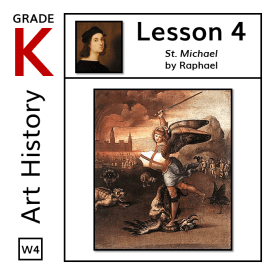
By: Raffaello Sanzio da Urbino (Raphael)
Week: 4
In 'St. Michael,' Raphael visualizes a battle between Archangel St. Michael, commander of God's army, and the monsters in hell. Wielding a sword and shield, Michael steps on the neck of a monster and raises his sword to deliver a killing blow. His fight is far from over. Many more monsters lurk nearby. A dark palace and swirling clouds loom in the background.
By: Raffaello Sanzio da Urbino (Raphael)
Week: 5
In 'Young Woman with Unicorn,' Raphael portrays a young blonde woman holding a small unicorn. The painting was a wedding gift and features the bride as the subject. The woman wears a burgundy and gold dress and a pendant with a red jewel and a pearl. Snowy mountains framed by pillars decorate the background. The unicorn symbolizes the historical notion of bridal purity.
By: Raffaello Sanzio da Urbino (Raphael)
Week: 6
In 'Ezekiel's Vision,' Raphael painted the vision of a biblical prophet named Ezekiel. The work shows the biblical God up in the clouds of the heavens with an angel, cherubs, an ox, a lion, and an eagle. In the lower left corner of the painting, bright rays of light shine down upon Ezekiel on Earth.
By: Sandro Botticelli
Week: 7
Sandro Botticelli's 'Adoration of the Magi' depicts the biblical scene of the Wise Men (Magi) traveling to worship newly born Jesus at the Nativity, a common subject for Renaissance art. Mary, Joseph, and Jesus reside in the center of the work. The Star of Bethlehem glimmers down to illuminate baby Jesus. The three kneeling men wearing red, black, and white/gold are the three Magi. The other people are the Magi's assistants. The three Magi have brought gifts to show their devotion to Jesus. The picture is set in ruins, but new plant life grows from the cracks promising new hope and rejuvenation.

By: Sandro Botticelli
Week: 8
Sandro Botticelli's 'Madonna of the Magnificat' shows the Madonna (Virgin Mary, mother of Jesus) holding baby Jesus and surrounded by wingless angels. Two of the angels place a golden crown of stars on Mary's head. Mary dips a pen into an inkwell, ready to write in an open book. The right side of the book shows the Magnificat, or the 'Song of Mary,' an ancient Christian hymn taken from the biblical Gospel of Luke. The left-hand page displays the 'Song of Zechariah,' also from the Gospel of Luke. Mary holds a pomegranate in her left hand, which may symbolize the story of Jesus' suffering and resurrection. The circular shape of the painting, common to the Renaissance, is known as 'tondo.' This tondo is enormous, and the figures are near life-size. Because of the size and lavish use of expensive gold paint, 'Madonna of the Magnificat' was the most expensive tondo painted by Botticelli.
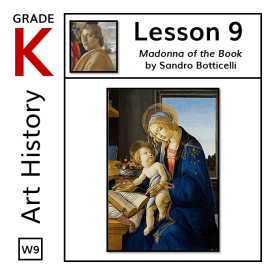
By: Sandro Botticelli
Week: 9
Sandro Botticelli's 'Madonna of the Book' shows the Christian Madonna (Mary, mother of Jesus) holding baby Jesus and reading a book common in the Middle Ages, called the 'Book of Hours.' This book is an illustrated Christian work of prayers, psalms, and texts. Mary wears a beautiful blue robe. Blue is often associated with royalty and heaven. The baby Jesus looks up at his mother. Jesus holds three nails and a crown of thorns, referencing the 'Passion of the Christ,' the time late in Jesus' life up until his death. The background holds a bowl of ripe cherries, figs, and plums, some boxes, and a window revealing trees and a blue sky.

By: Sandro Botticelli
Week: 10
Sandro Botticelli's 'Mars and Venus' features two figures from Roman mythology, the male Mars, Roman god of war, and the female Venus, roman goddess of love. Venus watches Mars as he sleeps with a solemn expression. Wasps swarm ominously close to Mars' head. Young satyrs frolic around them and play tricks. Two satyrs hold a lance, and one is about to blow a conch shell in Mars' ear. In the lower right corner, one Satyr lays under Mars wearing Mars' breastplate and holding a green fruit. The city of Florence and mountains appear in the distance. Two evergreen plants grow in the background, the laurel and the myrtle. The laurel is associated with Mars when he acts as a peace bringer. The myrtle is often associated with Venus.
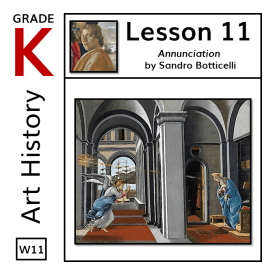
By: Sandro Botticelli
Week: 11
In Sandro Botticelli's 'Annunciation,' he portrays the angel Gabriel rushing to tell Mary that she is to become the mother of Jesus. Gabriel holds an olive branch in his hand, which may symbolize peace between God and man. The term 'annunciation' means 'an announcement.' Showing humility, Mary bows as she receives the news. Golden rays of light shine down from heaven bearing the good news. Botticelli painted the pillars and arches in the background in linear perspective, lending a three-dimensional feeling to the work.
By: Sandro Botticelli
Week: 12
In Sandro Botticelli's 'Esther at the Palace Gate,' one of six panels depicting the biblical story of Esther, he shows the beautiful maiden Esther outside the gates of a palace. Esther was summoned to the castle by the king, along with many other young women to compete for the role of queen. After twelve months of competition for the king's affections, the king selected Esther as the next queen.
By: Mary Cassatt
Week: 13
Mary Cassatt's 'Little Girl in a Blue Armchair' shows a little girl wearing a frilly dress in a blue armchair. Her hair is elaborately arranged and curled. Her slouched posture, scrunched up dress, and bored expression contrast with her fancy hair and fussy dress. A small Brussels Griffon dog curls up in a chair next to her. The visible brush strokes of color reveal the impressionistic nature of the work.
By: Mary Cassatt
Week: 14
In Mary Cassatt's 'A Woman and a Girl Driving,' a woman, a child, and a man ride in a horse-drawn carriage. The woman drives and rides in front with the child. The man rides in the back, his face only visible in profile. All three people wear serious expressions. This painting reflects the theme of 'women in control' seen in many of Cassatt's works.
By: Mary Cassatt
Week: 15
Mary Cassatt painted many little girls in hats, oftentimes smiling and wearing expensive dresses and elaborate hairdos. In contrast, in 'Child in a Straw Hat,' a little girl wears a drab dress and a plain, wide-brimmed hat. Her straw-colored hair flows loose and looks mussed. Her mouth turns down, and her sad eyes look like they may tear up. She clasps her hands in front of her, as if she's being chastised. This work is impressionistic in nature.
By: Mary Cassatt
Week: 16
Mary Cassatt's 'The Boating Party' shows three people in a sailboat. A relaxed woman holds a tired looking, sprawled out child while a blue-sashed man in black rows. It is hard to tell how the man feels, as we only see his profile. The sail billows with the wind, and faint lines of white in the water may represent whitecaps. The land in the background looks far away.
By: Mary Cassatt
Week: 17
Mary Cassatt's 'The Child's Bath' shows a woman bathing a child. The towel-draped child sits on the woman's lap. The woman wraps one hand around the child's waist and gently washes the child's foot with the other hand in a basin of water. A white pitcher rests nearby. Like Van Gogh, Cassatt was influenced by Japanese art and prints. In this picture, an oriental rug is visible.
By: Mary Cassatt
Week: 18
Mary Cassatt's 'Baby Reaching for an Apple' shows a woman encouraging a child's discovery of the world. A woman gently supports a baby while pulling down a branch of an apple tree to allow the child to examine and feel the fruit.
By: Vincent van Gogh
Week: 19
Vincent van Gogh painted 'Beach at Scheveningen in Stormy Weather 1882' outside on a windy day at the beach. Real grains of sand from that day are stuck in the paint. It depicts the sea outside a beach resort near The Hague, a city on the North Sea coast of the western Netherlands. In 2002, the painting was stolen from the Van Gogh Museum in Amsterdam in the Netherlands. Using a ladder, the thieves snuck past the security guards through the roof. Although the museum alarm went off, the thieves escaped. Two suspects were soon arrested and convicted, but the painting remained missing. In 2016, the painting was found in a house affiliated with organized crime near Naples, Italy.

By: Vincent van Gogh
Week: 20
In Vincent van Gogh's own words, 'A Girl in the Woods' features .'..some large green beech trunks on a stretch of ground covered with dry sticks, and the little figure of a girl in white. There was the great difficulty of keeping it clear, and of getting space between the trunks standing at different distances - and the place and relative bulk of those trunks change with the perspective - to make it so that one can breathe and walk around in it, and to make you smell the fragrance of the wood.'

By: Vincent van Gogh
Week: 21
Japonaiserie is the term Vincent van Gogh used to express the influence of Japanese artwork. Van Gogh collected hundreds of Japanese wood-block prints called ukiyo-e prints. 'Flowering Plum Tree' is based on a Japanese wood-block print by artist Hiroshige. The painting shows a flowering plum tree in an orchard. In the background, we see figures milling beyond a black fence. Because plum trees bloom amid winter to herald the upcoming spring, plum blossoms represent strength and endurance. The Japanese-looking characters framing the artwork are purely decorative and mean nothing.

By: Vincent van Gogh
Week: 22
Vincent van Gogh painted 'The Starry Night' based on the window view from his room in an asylum. Celestial swirls of haloed light shine from the night sky, including a crescent moon, stars, and Venus. A church steeple points upwards from amidst the sleepy village nestled underneath. A twisted cypress tree licks the sky like flames in the foreground. Cypress trees are associated with mourning and death, perhaps because they die when cut back too aggressively.
By: Vincent van Gogh
Week: 23
Vincent van Gogh's 'Wheat Field with Crows' shows three paths cutting through a golden field of wheat. A turbulent sky churns in shades of blue above. A murder of crows soars over the wheat, although it is unclear whether they are flying toward or away from the viewer. Crows have been called 'messengers of death' and associated with change and magic. In ancient Egypt, crows were a symbol of undying love, because they are monogamous by nature.
By: Vincent van Gogh
Week: 24
Vincent van Gogh's 'Memory of the Garden at Etten (Ladies of Arles)' depicts his mother and sister walking through a flower garden in his childhood town of Etten-Leur, Netherlands. His mother wears a blue and red checked shawl, and his sister wears a green and orange checked shawl and carries a red parasol. Another woman tends the flowers in the background. Further back are round flower beds.
By: Henry Ossawa Tanner
Week: 25
In 'The Banjo Lesson,' Tanner humanizes a stereotype in his time of black people as entertainers, particularly as caricatures playing banjos. In this painting, an elderly man teaches his young grandson how the play the banjo. He cradles his small grandson in his lap, and both are intent on their roles as teacher and pupil. Their surroundings are modest, and although the grandfather may not be able to shower his grandson with financial riches, he shares his rich knowledge and appreciation of music.
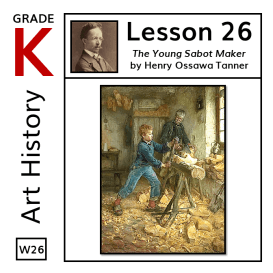
By: Henry Ossawa Tanner
Week: 26
Sabots are shoes constructed from a single block of wood. They were often worn by peasants in France and Britain between the 16th to 19th centuries. In 'The Young Sabot Maker,' Tanner shows a man teaching his apprentice how to construct the wooden shoes. The hardworking apprentice hollows out one of two wooden shoes propped up on a homemade table made of branches and a log, while the master looks on from the corner of the workshop. Additional shoes and countless wooden shavings litter the floor beneath. Shoes are everywhere, hanging from the ceiling and stacked against the wall.
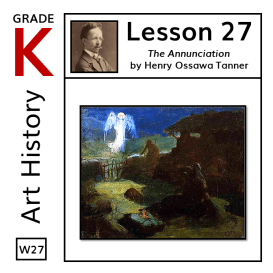
By: Henry Ossawa Tanner
Week: 27
Annunciation means 'an announcement.' In 'The Annunciation to the Shepherds,' Tanner painted the glowing angel, Gabriel, hovering above the ground and announcing the news of the birth of the baby Jesus to a group of humble shepherds. The shepherds appear to be in awe of the angel. The dim light of the small fire is insignificant compared to the holy light of the angel.
By: Henry Ossawa Tanner
Week: 28
In 'The Disciples See Christ Walking on the Water,' Tanner depicts a story from the New Testament of the Bible. The story tells of the miracle of Jesus walking on the Sea of Galilee in front of his devout followers, the disciples. The disciples were afraid at first, thinking Jesus a spirit, but Jesus told them not to be afraid. Jesus joined his disciples in the boat, and they continued their journey to the shore.
By: Henry Ossawa Tanner
Week: 29
The Arc de Triomphe de l'Étoile (Triumphal Arch of the Star) is a famous Parisian monument that honors soldiers that died in French wars. The names of the soldiers and their battles are inscribed on the monument surfaces. The 'star' is formed by the 12 roads that radiate out from the central monument. In 'The Arch,' Henry Ossawa Tanner shows the monument glowing out of the night and illuminating the crowd milling below.
By: Henry Ossawa Tanner
Week: 30
In 'Lions in the Desert,' Tanner shows lions camouflaged by a desert landscape. At first only one or two lions catch the eye, but upon closer examination, three lions appear. Tanner painted 'Lions in the Desert' while he was in the Middle East. He didn't actually see any lions while painting, but later added them back in his studio.

By: Georges-Pierre Seurat
Week: 31
'Ile de la Grande Jatte' translates to 'Island of Big Bowl.' The island is located on the river Seine at the gates of Paris. On Sundays, wealthy Parisians escaped the hot city to the cool, breezy riverfront of the island. Georges Seurat's 'Un dimanche après-midi à l'Île de la Grande Jatte (A Sunday Afternoon on the Island of La Grande Jatte)' features 3 dogs, 8 boats, and 48 people. Men, women, and children lounge on the grass and enjoy the river view, some in the shade and some in the sun. Many women hold parasols to shield their faces from the sun. One small girl in white looks directly at the painter/viewer. A lady holds a monkey on a leash. Two soldiers stand at attention. One lady extends a pole and fishes riverside. Sailboats drift over the river. A group of men wield paddles to propel a racing boat through the river. Seurat applied pointillism to create the painting.

By: Georges-Pierre Seurat
Week: 32
Georges Seurat often ventured to the coast to paint in the summertime. Port-en-Bessin is a small village on the Normandy coast. Normandy is a coastal region in northern France, just north of Paris, abutting the English Channel. 'Port-en-Bessin, un dimanche (Sunday at Port-en-Bessin)' features a view of a harbor. Several blue, white, and red French flags whip in the sea breeze over a collection of sailing vessels. People stroll on a bridge over the water in the distance. Seurat employed pointillism to create this painting.

By: Georges-Pierre Seurat
Week: 33
Georges Seurat's 'La tour Eiffel' (The Eiffel Tower) shows the incomplete Eiffel Tower just before its official 1889 unveiling in Paris, where it served as the grand entrance to the World Fair. The Eiffel tower has become the most visited fee-based tourist attraction in the world. Constructed of wrought iron, it is eighty-one stories tall and the tallest building in Paris. Seurat employed pointillism while painting 'La Tour Eiffel.'

By: Georges-Pierre Seurat
Week: 34
Georges Seurat's 'La Chahut' (English - The Can-can) invites us to attend a 19th century evening at 'La Moulin Rouge' cabaret in Paris, France. With a red windmill on its roof, the Moulin Rouge (English - Red Mill) is a landmark in Paris. 'La Chahut' shows dancers kicking their pointed feet into the air. Below the stage watch the conductor, musicians, and a few of the audience members. When Seurat painted this work, the Can-can was scandalous due to the high kicks and other gestures of the dance. Seurat used his technique of pointillism to create 'La Chahut.'
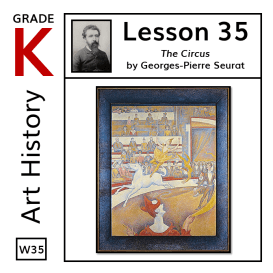
By: Georges-Pierre Seurat
Week: 35
Georges Seurat's 'The Circus' captures the essence of a 19th century Parisian circus. A daring lady in gold teeters on one leg atop a wild-eyed, galloping horse. Clowns with red-horned hair and white makeup jeer and perform acrobatics. A dashing ringleader in a black tuxedo holds a whip and manages the spectacle while an orchestra plays in the balcony above. Below the orchestra sits a group of tuxedo-wearing men. To the bottom left, ladies in hats and men in suits watch the show. The top left holds the cheap seats, evident from the casual attire of the audience. Unlike today's circuses, although a few children are present, most audience members are adults. Seurat did not finish 'The Circus' before he died. In some places, the white background and blue-lined grid underlying the painting can be seen. 'The Circus' offers another example of pointillism.

By: Georges-Pierre Seurat
Week: 36
Georges Seurat's 'Fishing in the Seine' shows men fishing in the Seine river, which flows through Paris, the capital city of France. Four men fish from the shore, and two more fish from a boat.